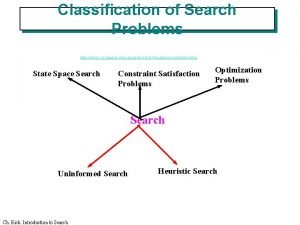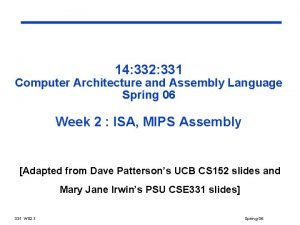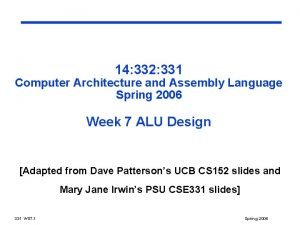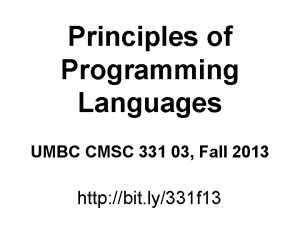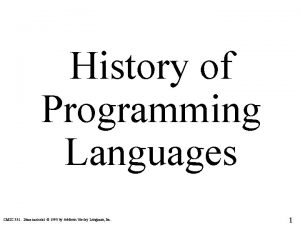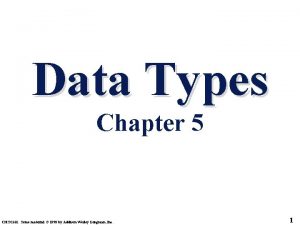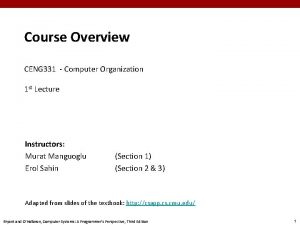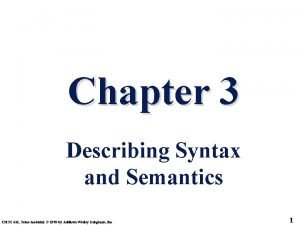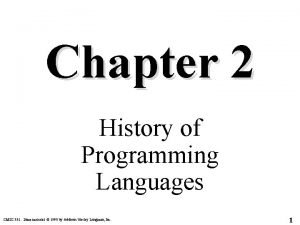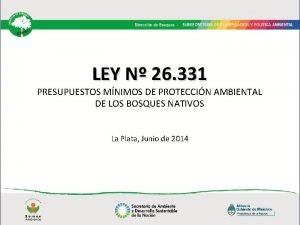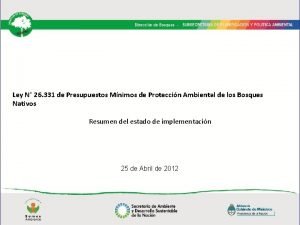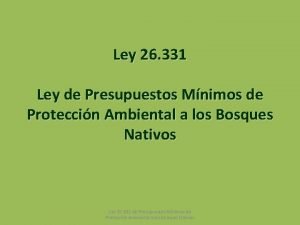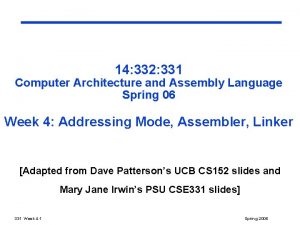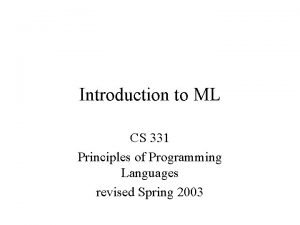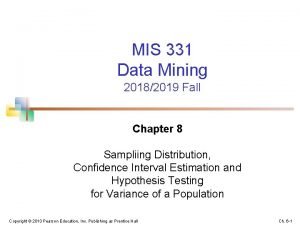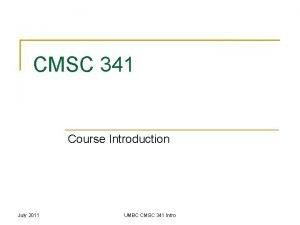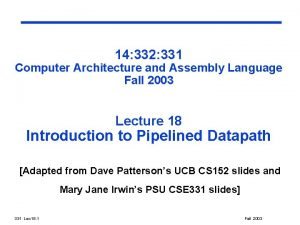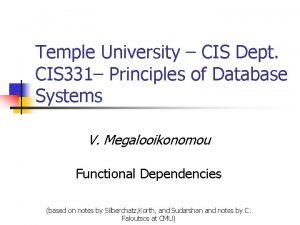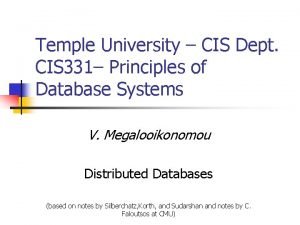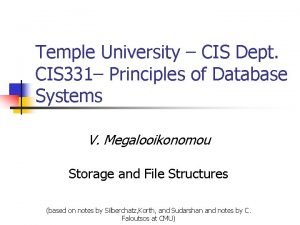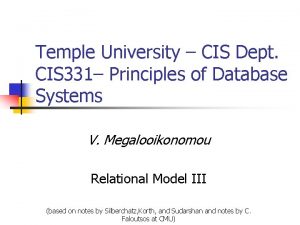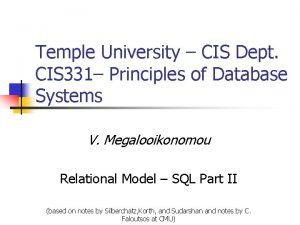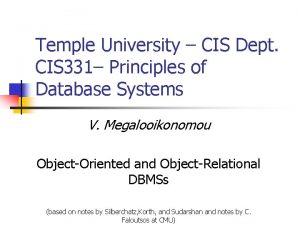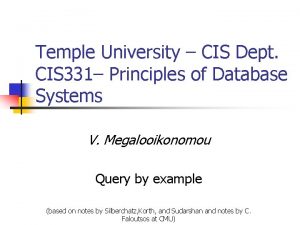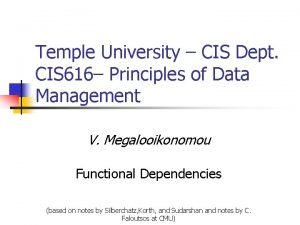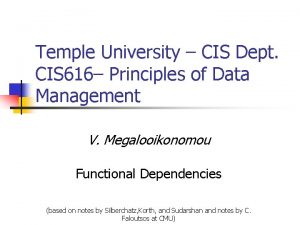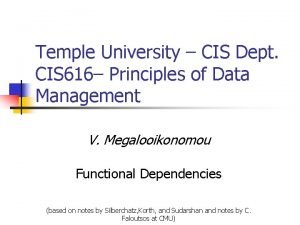Temple University CIS Dept CIS 331 Principles of





















































- Slides: 53

Temple University – CIS Dept. CIS 331– Principles of Database Systems V. Megalooikonomou Query Processing (based on notes by C. Faloutsos at CMU)

General Overview - rel. model n n n Relational model - SQL Functional Dependencies & Normalization Physical Design; Indexing Query processing/optimization Transaction processing Advanced topics n n Distributed Databases OO- and OR-DBMSs

Overview of a DBMS Naïve user casual user DML precomp. DML parser DBA DDL parser trans. mgr buffer mgr Data-files catalog

Overview - detailed n n n Motivation - Why q-opt? Equivalence of expressions Cost estimation Cost of indices Join strategies

Why Q-opt? n n SQL: ~declarative good q-opt -> big difference n e. g. , seq. Scan vs B-tree index, on P=1, 000 pages

Q-opt steps n n bring query in internal form (e. g. , parse tree) … into ‘canonical form’ (syntactic q-opt) generate alternative plans estimate cost; pick best

Q-opt - example p select name from STUDENT, TAKES Canonical form s where c-id=‘CIS 331’ and s STUDENT. ssn=TAKES. ssn STUDENT p TAKES STUDENT TAKES

Q-opt - example p Hash join; merge join; nested loops; STUDENT s Index; seq. scan TAKES

Overview - detailed n n n Why q-opt? Equivalence of expressions Cost estimation Cost of indices Join strategies

Equivalence of expressions n n n … or syntactic q-opt In short: perform selections and projections early More details: see transformation rules in text

Equivalence of expressions n n Q: How to prove a transformation rule? A: use TRC, to show that LHS = RHS, e. g. :

Equivalence of expressions

Equivalence of expressions

Equivalence of expressions n Selections n perform them early break a complex predicate, and push n simplify a complex predicate n n (‘X=Y and Y=3’) -> ‘X=3 and Y=3’

Equivalence of expressions n Projections n perform them early (but carefully…) n n n Smaller tuples Fewer tuples (if duplicates are eliminated) project out all attributes except the ones requested or required (e. g. , joining attr. )

Equivalence of expressions n Joins n n Commutative , associative Q: n-way join - how many diff. orderings? … Exhaustive enumeration too slow…

Q-opt steps n n bring query in internal form (e. g. , parse tree) … into ‘canonical form’ (syntactic q-opt) generate alt. plans estimate cost; pick best

Cost estimation n n E. g. , find ssn’s of students with an ‘A’ in CIS 331 (using seq. scanning) How long will a query take? n n CPU (but: small cost; decreasing; tough to estimate) Disk (mainly, # block transfers) How many tuples will qualify? (what statistics do we need to keep? ) 18

Cost estimation n Statistics: for each relation ‘r’ we keep n n Sr #1 #2 #3 nr : # tuples; Sr : size of tuple in bytes … #nr

Cost estimation n Statistics: for each relation ‘r’ we keep n n n Sr #1 #2 #3 … V(A, r): number of distinct values of attr. ‘A’ (recently, histograms, too) … #nr

Derivable statistics n n n fr: blocking factor = max# records/block (=? ? ) br: # blocks (=? ? ) SC(A, r) = selection cardinality = avg# of records with A=given (=? ? ) Sr #1 fr #2 … #br

Derivable statistics n n fr: blocking factor = max# records/block (= B/Sr ; B: block size in bytes) br: # blocks (= nr / fr )

Derivable statistics n SC(A, r) = selection cardinality = avg# of records with A=given (= nr / V(A, r) ) (assumes uniformity. . . ) – eg: 30, 000 students, 10 colleges – how many students in CST?

Additional quantities we need: n For index ‘i’: n n fi: average fanout - degree (~50 -100) HTi: # levels of index ‘i’ (~2 -3) n n ~ log(#entries)/log(fi) LBi: # blocks at leaf level HTi

Statistics n n Where do we store them? How often do we update them?

Q-opt steps n n n bring query in internal form (e. g. , parse tree) … into ‘canonical form’ (syntactic q-opt) generate alt. plans n n n selections; sorting; projections joins estimate cost; pick best

Cost estimation + plan generation n Selections – e. g. , Sr select * fr from TAKES where grade = ‘A’ n #1 #2 Plans? … #br

Cost estimation + plan generation n Sr Plans? n n seq. scan binary search n n #2 (if sorted & consecutive) index search n #1 fr if an index exists … #br

Cost estimation + plan generation Sr seq. scan – cost? n br (worst case) n br/2 (average, if we search for primary key) #1 fr #2 … #br

Cost estimation + plan generation Sr binary search – cost? if sorted and consecutive: n ~log(br) + n SC(A, r)/fr (=#blocks spanned by qualified tuples) n -1 #1 fr #2 … #br

Cost estimation + plan generation Sr estimation of selection cardinalities SC(A, r): non-trivial #1 fr #2 … #br

Cost estimation + plan generation Sr method#3: index – cost? n levels of index + n blocks w/ qual. tuples #1 fr. . . #2 case#1: primary key case#2: sec. key – clustering index case#3: sec. key – nonclust. index … #br

Cost estimation + plan generation Sr method#3: index – cost? n levels of index + n blocks w/ qual. tuples #1 fr. . #2 case#1: primary key – cost: HTi + 1 … HTi #br

Cost estimation + plan generation Sr method#3: index - cost? n levels of index + n blocks w/ qual. tuples #1 fr #2 case#2: sec. key – clustering index … OR prim. index on non-key …retrieve multiple records HTi + SC(A, r)/fr HTi #br

Cost estimation + plan generation Sr method#3: index – cost? n n levels of index + blocks w/ qual. tuples #1 fr. . . #2 case#3: sec. key – nonclust. index HTi + SC(A, r) (actually, pessimistic. . . ) … #br

Cost estimation – arithmetic examples n n find accounts with branch-name = ‘Perryridge’ account(branch-name, balance, . . . )

Arithm. examples – cont’d n n n-account = 10, 000 tuples f-account = 20 tuples/block V(balance, account) = 500 distinct values V(branch-name, account) = 50 distinct values for branch-index: fanout fi = 20

Arithm. examples n n n Q 1: cost of seq. scan? A 1: 500 disk accesses Q 2: assume a clustering index on branch-name – cost?

Cost estimation + plan generation Sr method#3: index – cost? n n levels of index + blocks w/ qual. tuples #1 fr #2 case#2: sec. key – clustering index … HTi + SC(A, r)/fr HTi #br

Arithm. examples n A 2: HTi + SC(branch-name, account)/f-account n n HTi: 50 values, with index fanout 20 -> HT=2 levels (log(50)/log(20) = 1+) SC(. . )= # qualified records = n n nr/V(A, r) = 10, 000/50 = 200 tuples SC/f: spanning 200/20 blocks = 10 blocks

Arithm. examples n n n A 2 final answer: 2+10= 12 block accesses (vs. 500 block accesses of seq. scan) footnote: in all fairness n n seq. disk accesses: ~2 msec or less random disk accesses: ~10 msec

Overview - detailed n n n Motivation - Why q-opt? Equivalence of expressions Cost estimation Cost of indices Join strategies

2 -way joins n n algorithm(s) for r JOIN s? nr, ns tuples each r(A, . . . ) s(A, . . . ) nr ns

2 -way joins n Algorithm #0: (naive) nested loop (SLOW!) for each tuple tr of r for each tuple ts of s print, if they match r(A, . . . ) s(A, . . . ) nr ns

2 -way joins n n Algorithm #0: why is it bad? how many disk accesses (‘br’ and ‘bs’ are the number of blocks for ‘r’ and ‘s’)? nr*bs + br r(A, . . . ) s(A, . . . ) nr ns

2 -way joins n Algorithm #1: Blocked nested-loop join n read in a block of r n read in a block of s n print matching tuples cost: br + br * bs r(A, . . . ) s(A, . . . ) nr, br ns records, bs blocks

2 -way joins n Arithmetic example: n n nr = 10, 000 tuples, br = 1, 000 blocks ns = 1, 000 tuples, bs = 200 blocks alg#0: 2, 001, 000 d. a. r(A, . . . ) 10, 000 1, 000 s(A, . . . ) alg#1: 201, 000 d. a. 1, 000 records, 200 blocks

2 -way joins n Observation 1: Algo#1: asymmetric: n n n cost: br + br * bs - reverse roles: cost= bs + bs*br Best choice? smallest relation in outer loop r(A, . . . ) s(A, . . . ) nr, br ns records, bs blocks

2 -way joins n n Other algorithm(s) for r JOIN s? nr, ns tuples each r(A, . . . ) s(A, . . . ) nr ns

2 -way joins - other algo’s n sort-merge n n sort ‘r’; sort ‘s’; merge sorted versions (good, if one or both are already sorted) r(A, . . . ) s(A, . . . ) nr ns

2 -way joins - other algo’s n hash join: n n n hash ‘r’ into (0, 1, . . . , ‘max’) buckets hash ‘s’ into buckets (same hash function) join each pair of matching buckets r(A, . . . ) 0 1 max s(A, . . . )

Structure of query optimizers: More heuristics by Oracle, Sybase and Starburst (-> DB 2) : in book In general: q-opt is very important for large databases. (‘explain select <sql-statement>’ gives plan)

Conclusions -- Q-opt steps n n n bring query in internal form (eg. , parse tree) … into ‘canonical form’ (syntactic q-opt) generate alt. plans n n selections (simple; complex predicates) sorting; projections joins estimate cost; pick best
 Temple university cis
Temple university cis Cis 331
Cis 331 Cis temple
Cis temple Temple university entrepreneurship
Temple university entrepreneurship Engineering temple run
Engineering temple run Irb temple
Irb temple Temple university disability services
Temple university disability services Study abroad application temple
Study abroad application temple Temple university admission requirements
Temple university admission requirements Temple university writing center
Temple university writing center Isss temple
Isss temple Temple university dba
Temple university dba Map of consciousness
Map of consciousness Temple university change password
Temple university change password Temple university undergraduate bulletin
Temple university undergraduate bulletin Ce 331
Ce 331 Ssis 331
Ssis 331 Uw cse 331
Uw cse 331 14:332:331
14:332:331 14:332:331
14:332:331 Affirmative easement
Affirmative easement Cse 331
Cse 331 Cse 332 p3
Cse 332 p3 Ist 331
Ist 331 Cmsc 331 umbc
Cmsc 331 umbc Cmsc 331
Cmsc 331 Ce 331
Ce 331 Ist 331
Ist 331 Cmsc 331
Cmsc 331 Cmsc 331
Cmsc 331 Cow metu
Cow metu Cmsc 331
Cmsc 331 Cmsc 331
Cmsc 331 In 331 bce, alexander the great successfully invaded egypt.
In 331 bce, alexander the great successfully invaded egypt. Ley 26 331
Ley 26 331 Ley 26 331
Ley 26 331 Ley 26 331
Ley 26 331 Komax gamma 333 manual
Komax gamma 333 manual Pred-331
Pred-331 14:332:331
14:332:331 Ist spring design
Ist spring design 2011 plc (cs) 331
2011 plc (cs) 331 Anth 331
Anth 331 Mist-331
Mist-331 Cmsc 331
Cmsc 331 Umbc cmsc 341
Umbc cmsc 341 14:332:331
14:332:331 Dept nmr spectroscopy
Dept nmr spectroscopy Florida department of agriculture and consumer services
Florida department of agriculture and consumer services Finance department organizational chart
Finance department organizational chart Worcester public health department
Worcester public health department Dept. name of organization
Dept. name of organization Mn dept of education
Mn dept of education Department of finance and administration
Department of finance and administration


